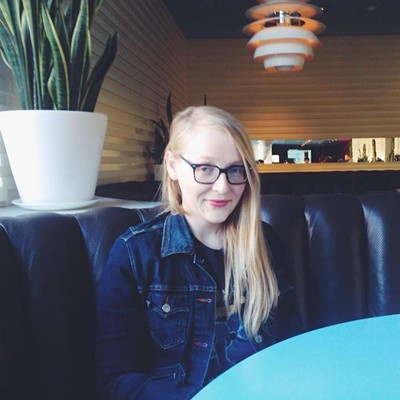Every other year, New Times puts the spotlight on Phoenix's creative forces — painters, dancers, designers, and actors. Leading up to the release of Best of Phoenix, we're taking a closer look at 100 more. Welcome to the 2016 edition of 100 Creatives. Up today is 85. Garth Johnson.
"I've meandered my way to the creative life I was born for," Garth Johnson says.
True, the path to becoming curator of the ASU Art Museum Ceramics Research Center wasn't a perfectly paved straight line. It started in Lincoln, Nebraska, led to studying art-making, and then to an associate professorship at College of the Redwoods in Eureka, California, followed by a curatorship at Philadelphia's The Clay Studio.
Regardless, Johnson's arrived. "I curate all of the exhibitions, coordinate the archive, and manage our collection," the 43-year-old says of his work at the Tempe institution he glowingly describes as home to "the best collection of postwar contemporary ceramics in the country."
Not that we'd debate him. The curator's mix of enthusiasm for and obsession with craft is certainly part of why he's joined the CRC, formerly helmed by Peter Held. It also makes the question of his favorite artwork all the more complicated.
"I guess I'm obligated to drool over something ceramic," Johnson says. "I'm a slavish fan of the work of ceramic artist Rick Dillingham, who ... donated thousands of hours over the course of his career to helping restore pots for the department of anthropology at the University of New Mexico."
Dillingham realized that his own pots would be stronger, Johnson explains, if they were broken and then repaired using the methods he employed with fixing the historical pottery. "His work speaks to me because it shuffles history in an innovative way."
I came to Phoenix with my lovely wife Claire and daughters Ramona (4) and Willa (2).
Well… I started as an artist. I have an MFA in ceramics from Alfred University. It took me a while to realize that I was much more valuable as a writer and curator.
I'm most productive when I'm working with energetic artists and community members. I love it when artists keep me on my toes.
My life is kind of one big inspiration wall. My house and my office are full of books. The ASU Art Museum Ceramics Research Center, where I work, is one big inspiration wall. I get to walk in the door each day and see the country’s best collection of contemporary ceramics, as well as one of the best archives in the field.
I've learned most from older artists. My mission in life is to preserve the legacies of brilliant artists who aren't as well-remembered as they should be.
Good work should always have a point of entry. I try to always think about ways to get audiences to engage with the work I present.
The Phoenix creative scene could use more places where artists from the dozens of little micro-scenes around town could converge and interact. I've only been in Phoenix for a year and a half, and I’m constantly surprised to find different clusters of creatives that don't interact with each other.
The 2016 Creatives so far:
100. Nicole Olson
99. Andrew Pielage
98. Jessica Rowe
97. Danny Neumann
96. Beth Cato
95. Jessie Balli
94. Ron May
93. Leonor Aispuro
92. Sarah Waite
91. Christina "Xappa" Franco
90. Christian Adame
89. Tara Sharpe
88. Patricia Sannit
87. Brian Klein
86. Dennita Sewell
[
{
"name": "Air - MediumRectangle - Inline Content - Mobile Display Size",
"component": "18478561",
"insertPoint": "2",
"requiredCountToDisplay": "2"
},{
"name": "Editor Picks",
"component": "16759093",
"insertPoint": "4",
"requiredCountToDisplay": "1"
},{
"name": "Inline Links",
"component": "17980324",
"insertPoint": "8th",
"startingPoint": 8,
"requiredCountToDisplay": "7",
"maxInsertions": 25
},{
"name": "Air - MediumRectangle - Combo - Inline Content",
"component": "16759092",
"insertPoint": "8th",
"startingPoint": 8,
"requiredCountToDisplay": "7",
"maxInsertions": 25
},{
"name": "Inline Links",
"component": "17980324",
"insertPoint": "8th",
"startingPoint": 12,
"requiredCountToDisplay": "11",
"maxInsertions": 24
},{
"name": "Air - Leaderboard Tower - Combo - Inline Content",
"component": "16759094",
"insertPoint": "8th",
"startingPoint": 12,
"requiredCountToDisplay": "11",
"maxInsertions": 24
}
]











